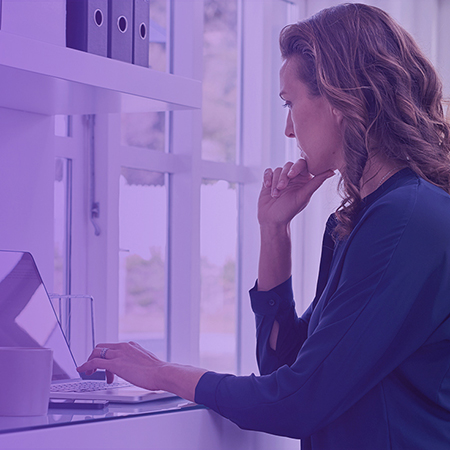Updated on July 13, 2023
Are you at risk? Telework was introduced at a breakneck speed in many organizations. But what about data security?
Attempts at phishing, ransoming and other data theft or malicious traffic disruptions have increased as fraudsters are taking advantage of the vulnerabilities resulting from people working from home.
In order to avoid high costs for your organization and the loss of customer confidence, it is essential to secure your data, monitor your networks’ security and have a cybersecurity plan to effectively and quickly respond to and mitigate cyber attacks.
To help you assess the situation, here are five aspects to keep in mind to ensure that your organization is minimizing its IT risks.
1- Adopt a policy
2- Safeguard data access
3- Train employees
4- Protect information and store it in a secure environment
5- Prepare a contingency plan
1. Adopt a policy on the use of computer security equipment
Make sure that all devices being used, including mobile devices, are designated for the worker and used only for the worker’s job. Additionally:
- Use a virtual private network (VPN) that secures access through encrypted authentication and encrypts sensitive data;
- Limit users’ ability to add applications through whitelisting (preapproved security applications) by controlling installation permissions;
- Provide a firewall—a barrier that filters incoming and outgoing data;
- Protect your networks and devices with a professional IT solution;
- Use a mobile device management solution to protect mobile devices from loss, theft, damage and unauthorized access;
- Ensure that all devices (personal or business-owned) that remotely connect to the entity’s resources meet the security requirements of the information security policy: for business-owned devices, the IT department must ensure that only software authorized for use on the entity’s resources is installed.
2. Safeguard data access
Make employees aware of the importance of best practices and implement secure user authentication mechanisms:
- Consider using multi-factor authentication (MFA) for all high-level access and access to sensitive data, applications and mission-critical environments;
- Include a screen saver with automatic lockout;
- Install regular automatic updates to anticipate security breaches;
- Disable wireless access to unused devices;
- Put advanced antivirus and anti-malware software on all devices that have access to the entity’s environment and data;
- Ensure that all sensitive data communications are encrypted (including email communications).
3. Train employees on working remotely
Provide ongoing training to make employees aware of key security issues and remind them of good practices:
- Detecting fraudulent emails and phishing attempts;
- Using a strong password;
- Never leaving a device unattended;
- Using a secure wireless network;
- Quickly contacting a resource person in case of a security issue, such as a lost device or detection of a problem (provide emergency contact information).
4. Protect information and store it in a secure environment
This is important at all times, but when everyone is working from home, the stakes are even higher: it is essential to provide a data backup environment.
- Back up data regularly by making copies that are stored securely and, ideally, in a cloud environment so that they can be accessed from any secure device;
- Limit employee access to the information they need to do their jobs. Limit access to the required individuals only or, in accordance with the “minimum privilege” principle, to minimize the risk of unauthorized access to sensitive data;
- Ensure that sensitive information is encrypted (e.g. intellectual property, personal identification information, registered credit card numbers, health care data): only access secure sites (HTTPS protocol) using devices provided by the employer.
5. Prepare an intervention plan: respond, manage, mitigate and recover
Whatever their size, all organizations are at risk of one or more cyber attacks during their lifetime. Unfortunately, this is even more so in this day and age, as malicious individuals are taking advantage of teleworking to infiltrate loopholes. It is essential that you have a contingency and risk prevention plan in the event of phishing, ransomware or other fraudulent attacks to:
- Assess potential threats;
- Closely monitor attack attempts;
- Anticipate the measures to be taken to protect your systems and data;
- Ensure that records are captured and monitored;
Rely on professionals to anticipate risks and assist you in monitoring and responding to cyber attacks.
Keep your business out of the reach of fraudsters. Contact our cybersecurity experts. They can offer solutions adapted to your organization and the assistance you need.
13 Aug 2020 | Written by :
Guillaume Caron is a cybersecurity expert at Raymond Chabot Grant Thornton. Contact him today!
See the profileYou could also like to read
Next article
Cultural, sports and tourism organizations have been hard hit by the pandemic. With locals and visitors having to completely change their habits, existing business models and financial frameworks have been upended.
In past few months, municipalities have been working hard to develop economic reopening plans. And it’s interesting to see how certain issues emerge time and again in these plans, such as: downtown centres, buy-local initiatives, cultural and sports scene vitality, green spaces and mobility (public transit and active transportation).
Municipalities have played a key role in managing the crisis. Based on our recent observations, we believe that municipal leadership will be just as important for the reopening phase.
The four pillars of municipal vitality
Everybody recognizes that municipalities play an important role in ensuring the provision of basic services, like public safety, roads, water and sewage systems, etc. Increasingly, however, individual citizens and businesses expect municipalities to actively lead projects aimed at making communities more dynamic, with a focus on four key areas:
- Cultural infrastructure and vitality: Libraries, theatres, cultural venues, etc.
- Dynamic downtown centres and economic development: Prospecting, commercial vitality, entertainment, urban beautification, placemaking, etc.
- Sports and recreation infrastructure and vitality: Green spaces, outdoor sports facilities, arenas, swimming pools, bike paths, parks, etc.
- Tourism appeal: Attractions, museums, festivals, conventions, accommodation, etc.
Interesting, distinctive municipalities are those that develop a clear vision and strategies for each of these pillars and that implement major initiatives to develop all four areas. The ability of municipalities to attract visitors, new residents and businesses depends on these pillars.
Capitalizing on the reopening to boost community vitality
Many organizations in these sectors are facing hardship due to the COVID-19 crisis. There’s a high risk that they could lose their assets and see years of hard work slip away in just a few months. Municipalities have tough decisions to make in terms of which assets are worth saving and how much support they can offer to those identified as top priorities.
But the crisis also presents an opportunity to shake things up and orchestrate transformations that might have otherwise taken years to get off the ground.
This is where things get complicated for municipal decision makers and local cultural, sports and tourism groups. Since there’s no established roadmap for Phase 2, they’re being forced to define a new approach in record time. In this context, business reopening plans must be based on fast yet detailed impact and opportunity assessments, as well as on innovation and agility.
Considerations for maximizing business reopening and financing opportunities
- Looking at demographic data, will local cultural and sports infrastructures meet the community’s needs once the crisis is over?
- Are there sports, culture or tourism organizations that could merge or pool their services to improve efficiency?
- Which tourist attractions and events support the municipality’s values and image? Which ones need to be refreshed with an updated vision and entertainment agenda?
- Does the municipal policy for supporting organizations suit today’s needs and reflect new approaches implemented since the pandemic began?
- Given the impact of the crisis on retailers and restaurants, what features will define the downtown area and attract people to the city core?
In the coming months, we can expect governments to unveil various financing programs (for infrastructure, optimization, innovation, technology, etc.) aimed at stimulating the economy. If municipalities and cultural, sports and tourism organizations want to get their share of available financing, they have to be ready with detailed plans.
Our team of experts specializing in tourism, leisure and culture can help you define your strategy. Contact us now.
11 Aug 2020 | Written by :
Denis Brisebois is a management consulting expert and leader in tourism, leisure and culture....
See the profileNext article
International Accounting Standards Board (IASB) amends the classification of liabilities as current or non-current.
Early in 2020, the International Accounting Standards Board (IASB) published Classification of Liabilities as Current or Non-Current (Amendments to IAS 1), which clarifies the guidance in IAS 1 Presentation of Financial statements on whether a liability should be classified as either current or non-current. In July 2020, the IASB deferred the application date to January 1, 2023.
Before the amendment, IAS 1 indicated that if an entity had an unconditional right to defer settlement of a liability for at least 12 months after the reporting period, then the liability is classified as non-current, if not, it is classified as current. Some preparers have found this indication confusing and consequently similar liabilities have been classified differently, making comparisons by investors difficult.
Next article
Updated on May 2, 2023
Telework has many benefits but there are also risks that shouldn’t be ignored. Take action to avoid burnout.
While telework offers many benefits to both employers and employees, it entails risks that are all too often ignored. It is very important to know how to detect the warning signs in order to act quickly and avoid serious health problems.
Here are some guidelines that may help you in your daily life as a teleworker.
Burnout: Are you at risk?
Burnout is a constant state of emotional, mental and physical exhaustion caused by prolonged and unresolved stress. Some of the causes of burnout include feeling “overwhelmed” by a demanding work schedule or the inability to cope with constant demands that keep piling up.
The inability to adapt to new duties or other new “contexts” can also lead to burnout. Remember, anyone—entrepreneurs, business owners, employees, freelancers, etc.—can experience burnout.
According to a U.S. study, the many factors that predispose or lead to a burnout include overwork and longer hours in a telework environment. These factors can have many negative effects on individuals, such as:
- Significant increase in stress;
- Lack of free time (work-personal life balance);
- Unclear boundaries between work and personal life;
- Below average performance (lower productivity);
- Presenteeism and resenteeism;
- Job dissatisfaction (staff turnover);
- Mental illness or depression;
- Physical health deterioration (absenteeism).
How to prevent burnout
Burnout and mental health issues are pervasive in the workplace. Despite the benefits of telework, such as the underlying flexibility, burnout and other health problems are likely to affect many people.
On the one hand, we must ensure optimal and effective management from a distance, but on the other hand, we have to deal with employees who do not have the experience or abilities to work virtually.
Discussions with entrepreneurs and business owners have revealed a lack of knowledge and a strong feeling of powerlessness in the face of this new and unique reality.
There is no doubt that working from home one to two days a week can be enjoyable and helpful. However, for many people, “full-time” telework is not necessarily an obvious or easy option. Furthermore, some individuals were previously in at-risk or special situations
Our analysis shows that people who are more vulnerable or have more difficulty adapting to changes in environment or methods will be more affected and experience more emotional and physical disruption.
The symptoms
One way to avoid burnout is to know—and be able to recognize—the potential and imperceptible warning signs that may arise. Some of the most common ones include:
- Less motivation regarding work;
- Irritability, sudden anger;
- Cynicism and frustration;
- Feelings of incompetence;
- A desire to isolate oneself;
- A sense of failure, low self-confidence;
- Anxiety;
- Difficulty concentrating, memory loss;
- Difficulty making decisions, confusion.
Burnout affects everyone, regardless of social background, age or job title. If you feel that something is wrong and you’re experiencing burnout symptoms, it’s time to change the way you work.
Take a few breaks
There are several benefits to working from home, including more flexibility. It’s up to you to take full advantage of these benefits. While you are supposed to follow a general work schedule, it should not be too rigid. It’s perfectly normal to play outside with your children, have lunch with friends, go out for coffee, etc.
Don’t put too much pressure on yourself in terms of your workload. When working remotely, you can set your own schedule and work at your own pace. If taking breaks helps you relax and recharge in order to bounce back, go ahead and do it. Occasional activities during work hours can also help you stay alert and maintain your productivity.
When working from home, some people tend to stay at their desks all the time and not take regular “short” breaks like they would at the office. You can easily become too absorbed in your work and end up working non-stop for hours at a time, which can eventually lead to burnout.
Take random breaks to get out of your chair: eat snacks, stretch when you start to feel cramped, go for a walk, do a mini workout or yoga. It’s recommended you take a short five-minute break every half hour to help you stay focused for a longer period of time and improve your productivity. A short break also gives your eyes a rest and helps prevent headaches.
Discipline
Do you feel like you’re always working outside the normal work schedule? Do you work evenings and weekends to make up for a heavy workload and an email backlog? That’s not normal.
You need to set your boundaries and provide a structure for your work. Here’s a tip: work in a “planned” way by setting time slots and sticking to them. If you don’t plan your workday, chances are you’ll work beyond regular hours, a situation that could potentially lead to burnout. In addition, if you feel your workload is excessive or greater than what you are used to managing, share your concerns with your manager.
Communication and interactions
Suddenly finding yourself working at home alone, without colleagues or social interaction, can create a sense of loneliness and isolation. Outgoing people who thrive on social interaction are particularly susceptible to this. However, working from a distance does not necessarily mean that you should stop communicating with colleagues, managers and other professional contacts.
Schedule video calls, call someone, chat with other team members to stay connected. You can discuss business issues, indulge in informal conversation and make jokes to relieve stress. Take advantage of the many technological tools at your disposal to exchange with your “external” professional network as well.
The right technology tools
Telework come with its share of challenges, including the potential for less team collaboration and more complex project management, which can increase employee stress. Using the right tools and equipment is crucial to making task management easier and collaborating with others effectively. Using outdated or inefficient technologies can hinder project progress and decrease users’ motivation.
Integrating proven project management and collaboration tools can make things much easier for employees. Whether it’s time management, task assignment, custom reporting, file viewing, the investment will be worth it, as it will improve efficiency and the overall work experience.
Balance
Without a doubt, another risk factor for remote workers is complete isolation. Don’t become a hermit. You’re already dealing with the absence of the usual social and physical interactions with colleagues.
Disconnect from work at the end of the day. Go out with the family, play with the kids in the park, eat out if possible, go running. Don’t let remote work invade your personal time. Ensure a work-life balance to keep your morale up and maintain your overall health.
Ergonomics
Not everyone has a comfortable, ergonomically designed office at home. However, working at home should not mean working all day from the bed or couch. Spending long hours in an uncomfortable position will inevitably cause muscle tension. Perhaps your body is already telling you that it’s time to do something about it.
Also, regardless of whether or not your workstation is ergonomic, sitting in front of your computer for long hours is not recommended. Change positions and posture and, above all, take short breaks every hour. If necessary, set an alarm to remind you. Stand up, stretch and walk.
It goes without saying that an exclusive space solely for working from home can help define the boundary between your personal and professional life. It also lets your family members know that you have work to do and that frequent interruptions can affect your productivity. Whenever possible, don’t work in the bedroom or living room; these environments should remain rest areas.
Burnout is not something you catch, it’s something you experience.
Stay alert to the warning signs and follow the various tips. Develop a comprehensive “wellness” strategy to preserve your quality of life, both personal and professional, during this extraordinary period.
Remember that a good work-life balance and contact with colleagues and those around you, even virtual contacts, will help you cope with the challenges of working from home.
Would you like to be better equipped to support your management teams during these exceptional times? Are you concerned that some of your employees may be at risk of burnout? Contact our experts for valuable advice geared to your situation.
06 Aug 2020 | Written by :
Jean-François Boudreault is a RH expert at Raymond Chabot Grant Thornton.
See the profile







